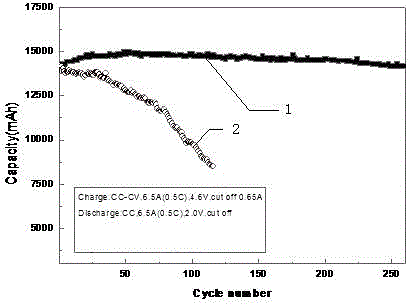A cycle-improved lithium-rich manganese solid solution battery
A solid solution, lithium-rich manganese technology, applied in secondary batteries, circuits, electrical components, etc., can solve problems such as poor cycle performance and unstable structure of lithium-rich manganese cathode materials, and achieve improved cycle life, high capacity, and reduced production costs low effect
- Summary
- Abstract
- Description
- Claims
- Application Information
AI Technical Summary
Problems solved by technology
Method used
Image
Examples
Embodiment 1
[0018] The positive active material is 0.5Li[Li 1 / 3 mn 2 / 3 ]O 2 0.5LiNi 1 / 3 co 1 / 3 mn 1 / 3 o 2 , the conductive agent is a mixture of carbon nanotubes and carbon nanofibers, the positive electrode binder is polyvinylidene fluoride, and the mass percentages of each component are: positive electrode active material 90%, positive electrode conductive agent 4% (wherein carbon Nanotube 1%, carbon nanofiber 3%) and positive electrode binder 6%.
[0019] The negative electrode active material is a mixed material of artificial graphite and soft carbon, the negative electrode conductive agent is a mixture of conductive carbon black and carbon nanotubes, the negative electrode binder is sodium carboxymethyl cellulose and styrene-butadiene rubber, and the mass percentage of each component is For: artificial graphite 65%, soft carbon 25%, conductive carbon black 4%, carbon nanotube 2%, carboxymethyl cellulose sodium 1.8% and styrene-butadiene rubber 2.2%.
[0020] In the electrolyte...
Embodiment 2
[0022] The positive active material is 0.2Li[Li 1 / 3 mn 2 / 3 ]O 2 0.8LiNi 1 / 2 mn 1 / 2 o 2 , the conductive agent is a mixture of carbon nanotubes and carbon nanofibers, the binder is polyvinylidene fluoride, and the mass percentage of each component is: positive electrode active material 84%, conductive agent 8% (wherein carbon nano tube 3%, carbon nanofiber 5%), and positive electrode binder 8%.
[0023]Negative electrode active material is artificial graphite, natural graphite and soft carbon mixed material, conductive agent is conductive carbon black, carbon nanotube, binder is sodium carboxymethyl cellulose and styrene-butadiene rubber, and the mass percent content of each component is : Artificial graphite 50%, natural graphite 25%, soft carbon 10%, conductive carbon black 4%, superconducting carbon 4%, carbon nanotube 1%, carboxymethyl cellulose sodium 2.5%, styrene-butadiene rubber 3.5%.
[0024] In the electrolyte, the lithium salt concentration is 1.0mol / L, wherein...
Embodiment 3
[0026] The positive active material is 0.6Li[Li 1 / 3 mn 2 / 3 ]O 2 0.4LiNi 0.8 mn 0.15 Mg 0.05 o 2 , the conductive agent is a mixture of carbon nanotubes and carbon nanofibers, the binder is polyvinylidene fluoride, and the mass percentage of each component is: positive electrode active material 75%, conductive agent 10% (wherein carbon nano tube 3%, carbon nanofiber 5%), positive electrode binder 15%.
[0027] The negative electrode active material is a mixed material of natural graphite and soft carbon, the conductive agent is conductive carbon black, superconducting carbon, the binder is sodium carboxymethyl cellulose and styrene-butadiene rubber, and the mass percentage of each component is: natural graphite 60%, soft carbon 20%, conductive carbon black 7%, superconducting carbon 5%, sodium carboxymethyl cellulose 3.6%, styrene-butadiene rubber 4.4%.
[0028] In the electrolyte, the lithium salt concentration is 0.8mol / L, wherein LiBOB accounts for 25% of the total li...
PUM
 Login to View More
Login to View More Abstract
Description
Claims
Application Information
 Login to View More
Login to View More - R&D
- Intellectual Property
- Life Sciences
- Materials
- Tech Scout
- Unparalleled Data Quality
- Higher Quality Content
- 60% Fewer Hallucinations
Browse by: Latest US Patents, China's latest patents, Technical Efficacy Thesaurus, Application Domain, Technology Topic, Popular Technical Reports.
© 2025 PatSnap. All rights reserved.Legal|Privacy policy|Modern Slavery Act Transparency Statement|Sitemap|About US| Contact US: help@patsnap.com



